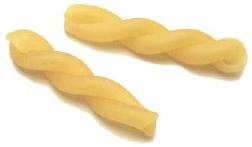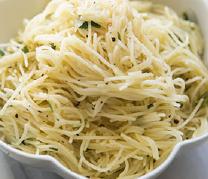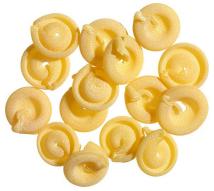
In Italian, spago means "string". Remove the final "o" and add the diminutive ending –etto, and you get spaghetto, meaning "little string". Following the regular rule for masculine nouns, its plural is spaghetti, meaning "little strings". So the Flying Spaghetti Monster turns out to be a hidden reference to that most modern of cosmological hypotheses, String Theory!
The derivation of the name of this pasta starts with stella, meaning "star". Removing the final "a" and adding the feminine diminutive ending –ina gives stellina, meaning "little stars", which is obviously what they look like. Note 1
This revelation is further hidden from English speakers, who call these "bow-ties". But I know a butterfly when I see one. There are other heavenly references known in the secret halls of the Pastafarians, coded in pasta. Consider the Ring Nebula, echoed in anellini (from anello, "ring", plus –ino = anellino, "little ring", plural anellini):  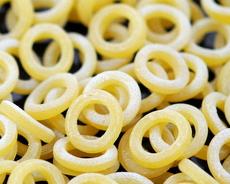 We all know of the constellation Gemini, one of the astrological signs of the Zodiak. The word gemini is Latin for "twins", and the constellation is usually taken to represent the twin brothers Castor and Pollux, from Greek mythology.
So can we ignore the obvious reference to the double-helix of DNA, basis of our genetic heritage?
And assistants, his angels. These are commemorated in the pasta capelli d'angelo, in English "angel-hair pasta", seen to the left. As befits their lesser status, their noodly appendages are much thinner and lighter than those of the Flying Spaghetti Monster himself. But were the angels our only flying visitors?
Which brings us full circle back to the Flying Spaghetti Monster, who, having created the world, clearly went on to create pasta in all its wondrous forms. Who else could have passed on to the Italians the sheer genius to create an entire gamut of dishes out of a single basic substance, paste (a Wikipedia page called List of Pasta counts 68 different types). I normally post a blog entry every Thursday evening. But because of the urgency of the revelations contained herein, I'm posting this entry two days early, today, April 1, 2014.
  Note 1: Throughout this entry, you'll learn about Italian diminutive endings. All nouns in Italian are either masculine or feminine, and diminutive endings can be added to make whatever the noun represents smaller. Generally, the original final vowel is removed before adding the ending. Endings added to masculine nouns usually end in "o", and to make the noun plural, the "o" usually changes to an "i". Endings added to feminine nouns usually end in "a", and to make a plural, the "a" usually changes to an "e". Thus we've seen that adding –etto to the masculine noun spago ("string") gives spaghetto ("little string", plural spaghetti), and adding –ina to the feminine noun stella ("star") gives stellina ("little star", plural stelline). You can figure out the rest yourself. Pretty much all the Italian words for types of pasta are plural. For more on that subject, see my earlier blog entry Biscotti (bis). There you can also learn about why there's an "h" in spaghetti. It's needed to maintain the hard pronunciation of the "g", because a "g" directly in front of an "e" would be soft. That is, spagetti would be pronounced "spa-JET-tee" (think of the pronunciation of the Italian ice cream geloto). The English word "pasta" comes from the identical Italian word - in Italian, it means "paste". Curiously, the Italian plural of the word pasta is paste (pronounced sort of like "POSS-tay"). I italicized one Latin word and all Italian words in this entry (hmm, "italicize", that seems appropriate). [return to text]
 |
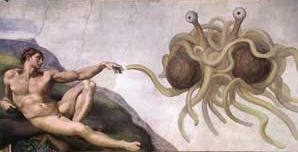 A "Pastafarian" is a follower of the
A "Pastafarian" is a follower of the 

 Did they avoid the inquisition by again coding their discoveries in the form of a pasta, the well-known farfalle, seen to the right? Farfalle in Italian means "Butterflies". A long time ago, in a galaxy far, farfalle away.
Did they avoid the inquisition by again coding their discoveries in the form of a pasta, the well-known farfalle, seen to the right? Farfalle in Italian means "Butterflies". A long time ago, in a galaxy far, farfalle away.
